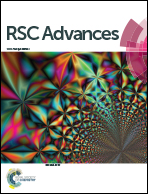Functionalized mesoporous silica material and anionic dye adsorption: MCM-41 incorporated with amine groups for competitive adsorption of Acid Fuchsine and Acid Orange II†
Abstract
Adsorption of two representative anionic dyes (Acid Fuchsine (AF) and Acid Orange II (AO)) using MCM-41 functionalized with amine groups in a mesoporous silica framework (NH2–MCM-41) as the adsorbent was investigated. Characterization of the modified adsorbent was studied by BET, FTIR, XRD and SEM. Various parameters including solution pH, adsorbent dosage, contact time, initial dye concentration and temperature were systematically studied. The results showed that the adsorption process was pH dependent, and the maximum adsorption capacity for AF was approximately 140.60 mg g−1 at pH 2.0 and 25 °C with a NH2–MCM-41 dosage of 2.0 g L−1, and 278.38 mg g−1 for AO at pH 3.0. In single component systems, equilibrium data fitted well the Langmuir and D–R models, suggesting the adsorption to be monolayer and physical in nature. Kinetic studies showed that the adsorption process could be better described by both the Lagergren pseudo-second-order and the Spahn and Schlunder models. Moreover, it was found that the adsorption was governed by film diffusion followed by intraparticle diffusion. Thermodynamic constant values (ΔGo < 0, ΔHo < 0 and ΔSo < 0) demonstrated that the adsorption reactions of AF and AO onto NH2–MCM-41 were feasible, spontaneous and exothermic under the examined conditions. For binary component systems, AF and AO exhibited competitive adsorption onto NH2–MCM-41, and adsorption capacity values of AF and AO were reduced compared to those of the corresponding single component systems. Furthermore, both in single and binary component systems, the experimental data could be better described by the Langmuir isotherm and the pseudo-second-order kinetic models.


 Please wait while we load your content...
Please wait while we load your content...